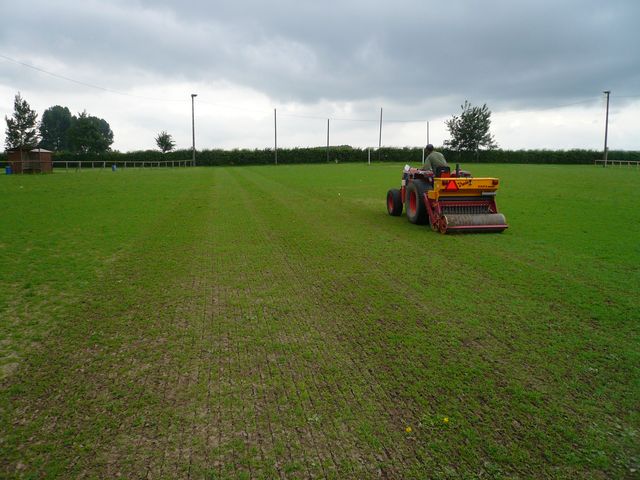
When should overseeding be done?
The period for regenerating football pitches comes at the end of the competition season, in May/June. Note that a second seeding can be done at the start of the season. Nine times out of ten, traditional overseeding is the option chosen. Complete regeneration, including scalping the ground, is performed when damage is too severe and on pitches that will allow it. Using a machine (like the Koro Topfield Maker) actually entails a certain cost, and the ground cannot be used for some time afterwards.
Les différentes étapes d’une régénération en sur semis :
1Sanding
Spreading sand makes it possible to improve the texture and structure of the soil over the first few centimetres. Between 30 and 60 tonnes of sand are uniformly distributed over the pitch. This operation can be reputed if necessary several times a year, but its effectiveness will be optimum during the grass growing period of grass growth. Too heavy a sanding risks stifling the grass and allowing matting to proliferate. It’s better to use regular sanding in accordance with soil analysis. Certain pitches benefit from monthly “top dressing” with sand. So the pitch does actually get higher from year to year! After a Koro-type machine has been used several times for scalping the ground, the original level is restored.
Can the sand wear down the robot mower blades?
No, as the sand does not stay on the surface; watering makes it penetrate more easily. To have an idea: 90 tonnes of sand spread over a 7140 m² pitch are going to represent a height of just 0.8 cm. Which is a lot lower than the recommended cutting height of 4 cm. On a golf green, on the other hand, yes, the blades are going to be subject to the sand, as the cut height there is only 4 mm.
2Aeration
Trampling by players, maintenance machine movements, precipitation, and natural settling of the soil can cause the ground to be compacted. Now the soil’s air/water balance is a determining factor in obtaining a healthy, long-lasting pitch surface. Hollow tine aeration is rarely performed on football pitches, but it is used on golf greens, where the low grass height allows it to be implemented easily. Deep-tine aeration using Verti-Drain is preferred for football pitches.
3Overseeding
Between 150–300 kg of 100% rye grass are spread over the pitch. The type of seeder used will determine the number of passes needed. The fertilizer must contain a higher proportion of phosphorus so as to stimulate the young seedlings. And very low salt content is required, as salts in the fertilizer will have a greater effect on the young seedlings than on more mature grass. Hence this salinity index is a parameter not to be overlooked in sowing or overseeding. On the contrary, opting for an agricultural fertilizer, laden with salt, will affect the effectiveness of the regeneration and hence on the quality of the pitch.
4Watering
The watering step is tricky. The idea is to keep the ground damp, but not sodden. It is recommended to water as often as necessary, depending on the weather. A hydrometric probe makes it possible to check the moisture level, but checking by hand can do the job perfectly well too. It’s a question of keeping the top 2–3 cm of soil moist, as the young shoots’ root systems don’t allow them to go deeper to look for water. The air/water ratio, already mentioned at the aeration step, is important. Air is essential to avoid stifling the soil.
How long to obtain a carpet of grass?
Using rye grass and with optimum watering conditions, the plant is capable of sprouting in 4 days, to start rolling in 15 days, and to form a carpet of young grass in 3 weeks. But watch out, these various steps can take much longer. They depend in particular on the monitoring and the type of fertilizer.
Can we mow during the regeneration?
What about mowing during this regeneration process? If there is still a relatively dense carpet of grass, robots can be put into operation directly on the ground. Their blades, changed just before regeneration, are sharp enough to cut the young grass. The cutting height is raised to 4 cm and, once the grass is strong enough, it can be lowered. Where the ground is very bare, you must wait 1 to 2 weeks before using the robot on the ground. The cutting height can then be raised to 5 cm and then lowered gradually.
Regeneration boosted thanks to the robot mower
The mulch from the robot mowers allows faster grass regeneration than that from traditional mulching cylinder mowers. Mowing frequency (up to 10 cuts per week, against 1 or 2 using traditional mowing methods) will lead to finer cuts, and hence much finer clippings which will be more easily attacked by the micro-organisms. The decomposition will be more efficient, which avoids the formation of dense matting. Then the nutrients will be returned very rapidly. The grass is constantly being cut, which allows a regular fertilizer plan, thereby offering the club savings and a reduction in its environmental impact.